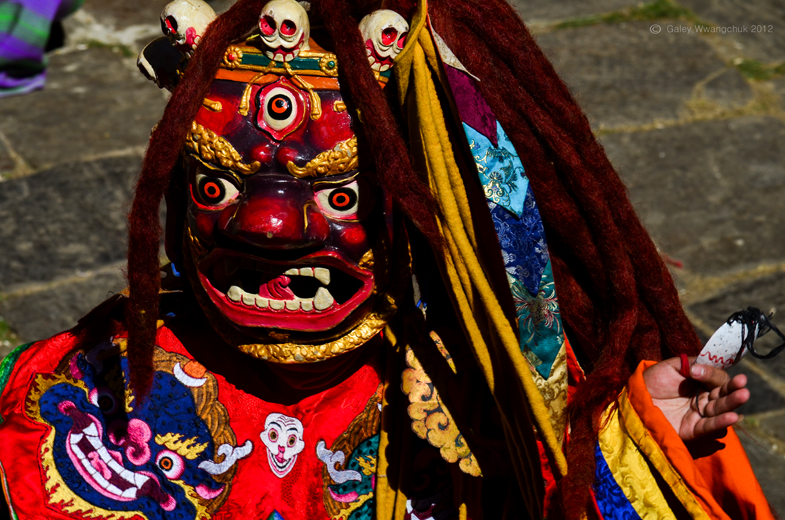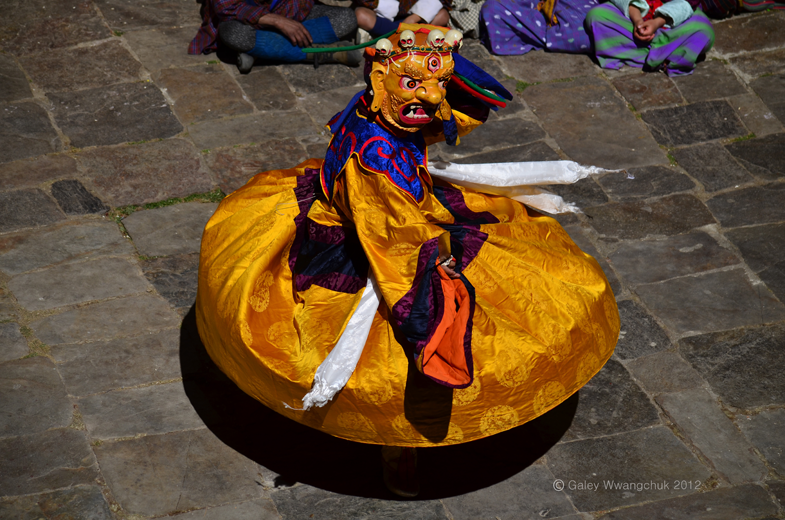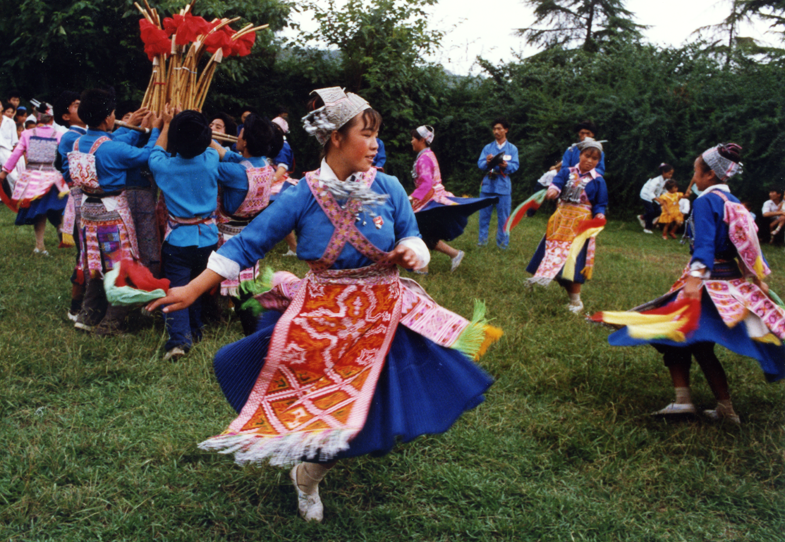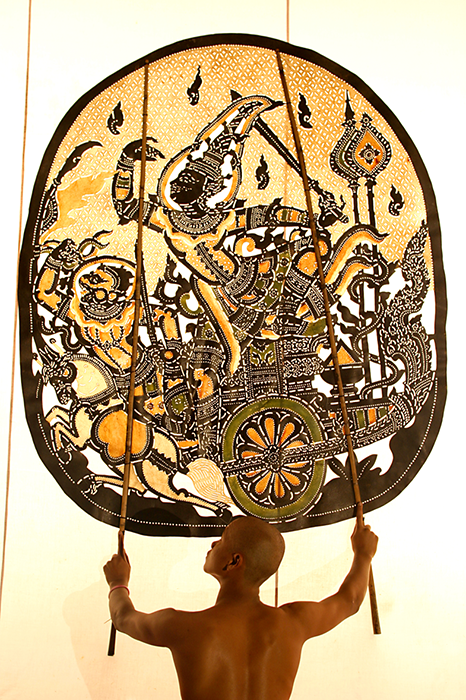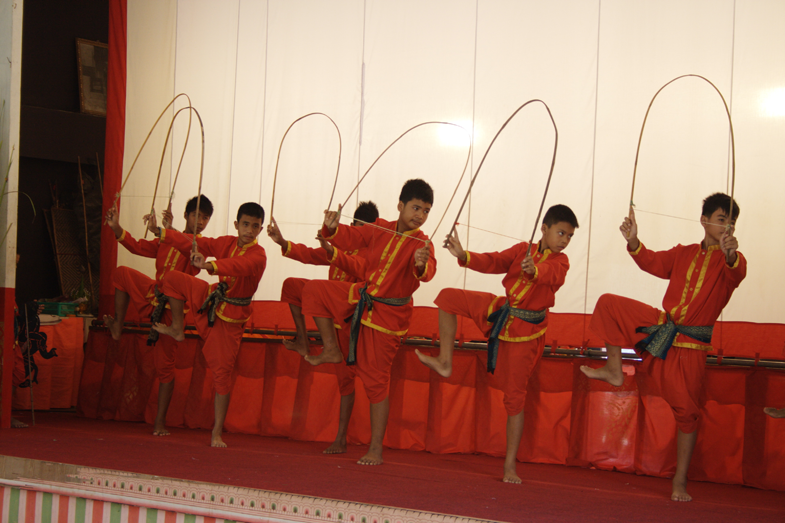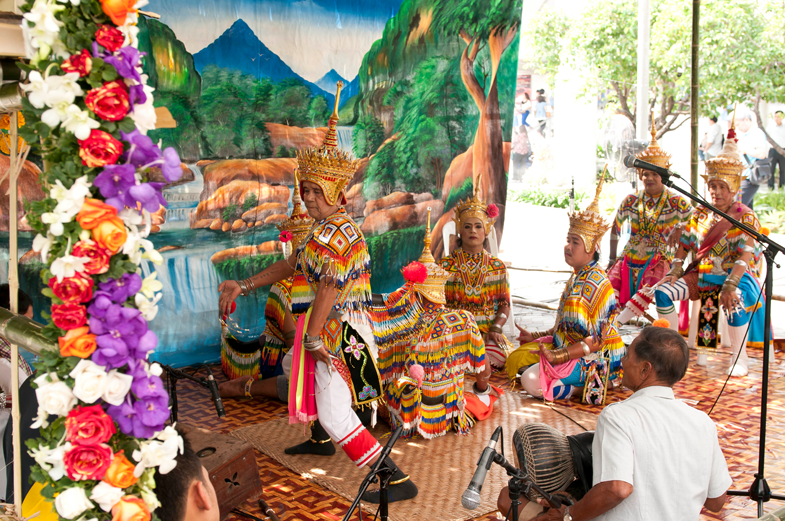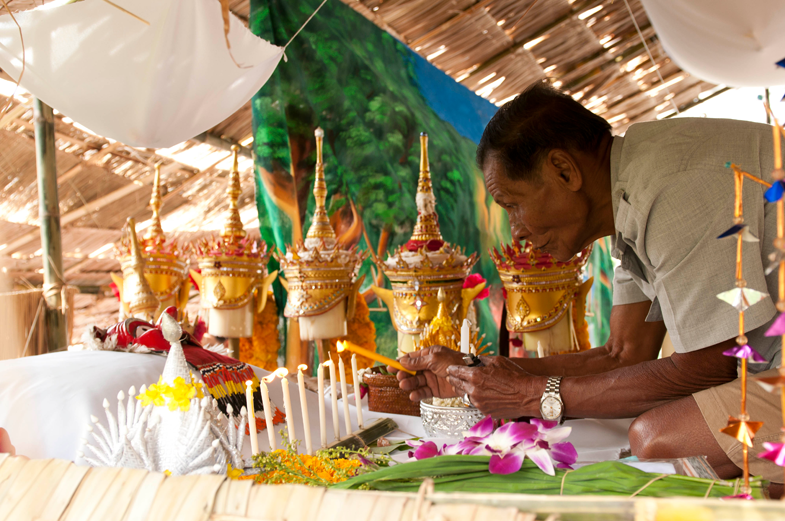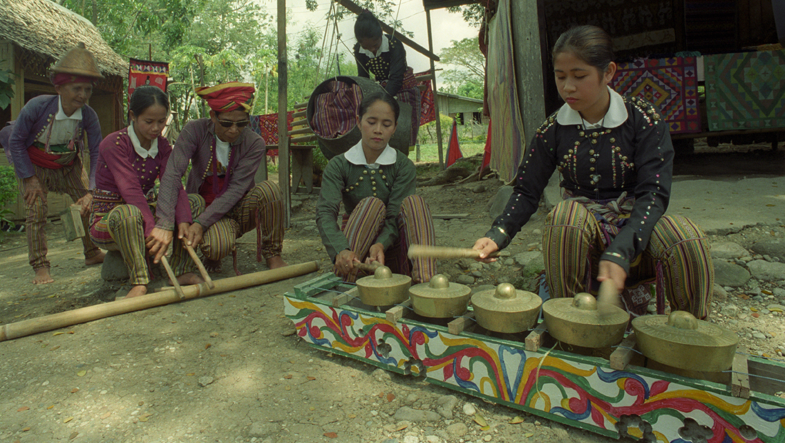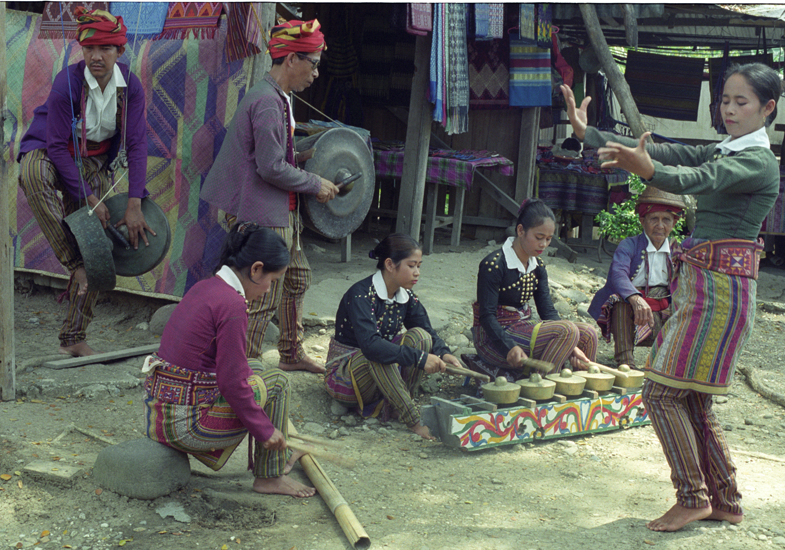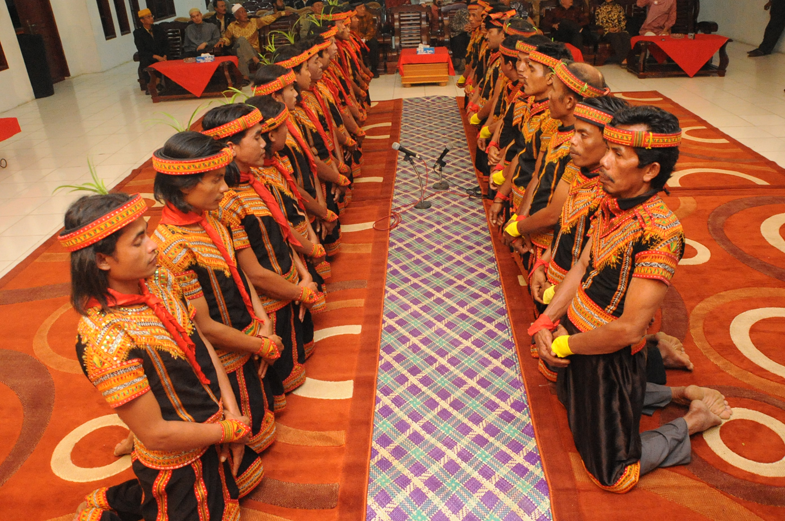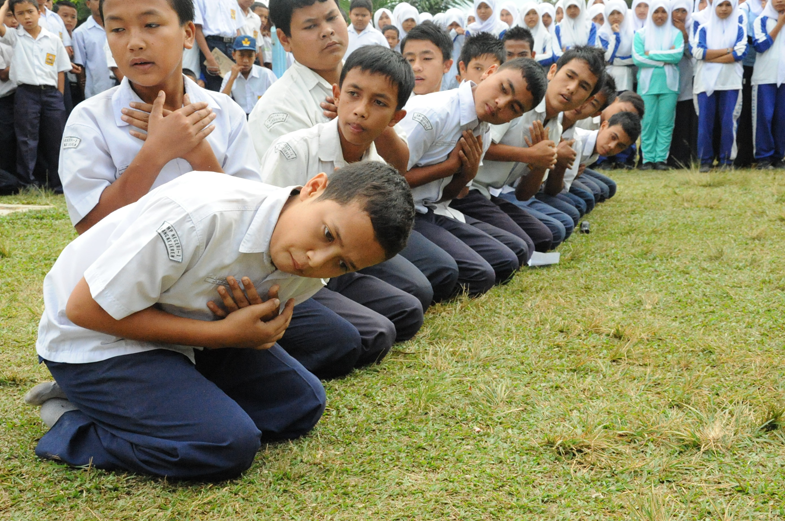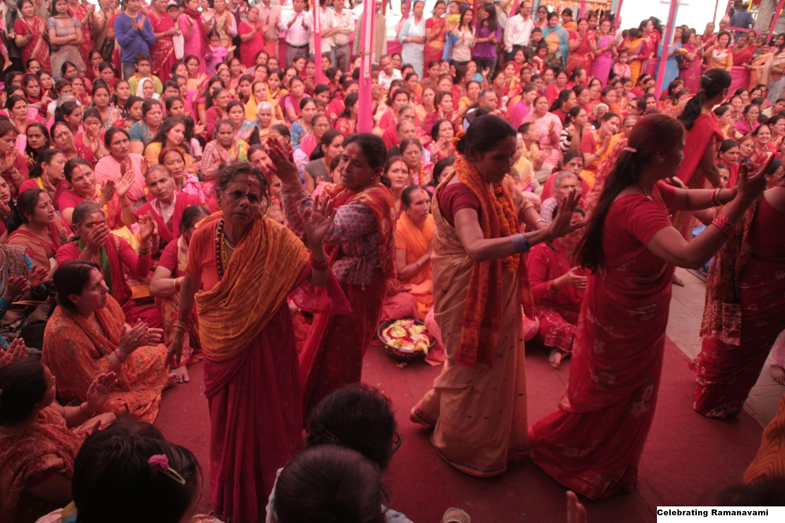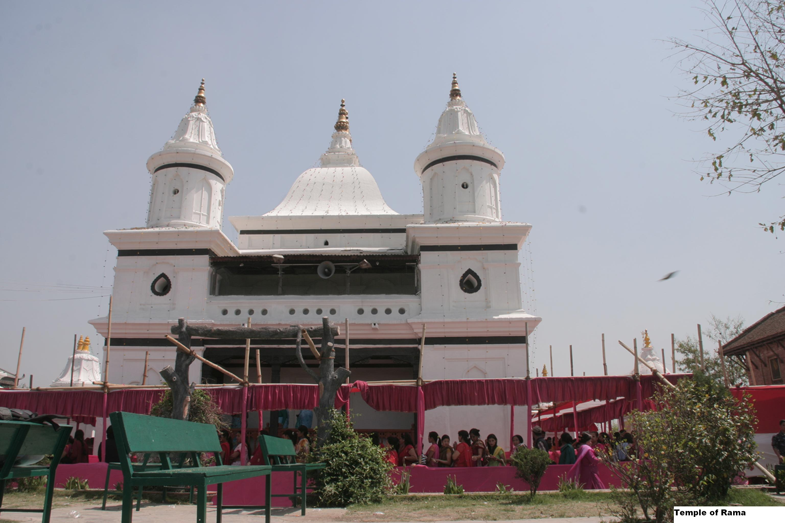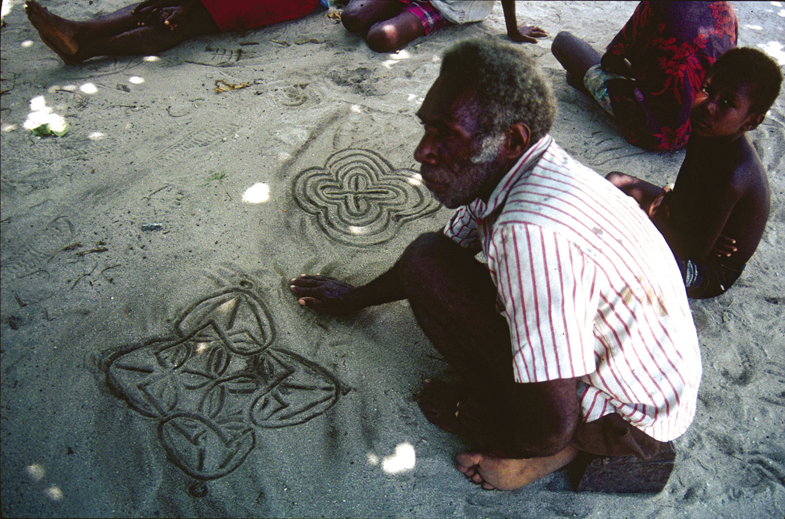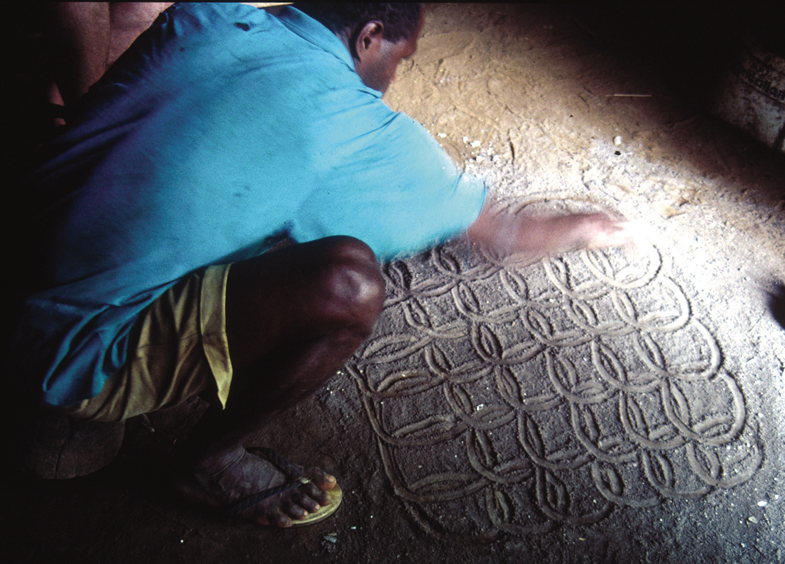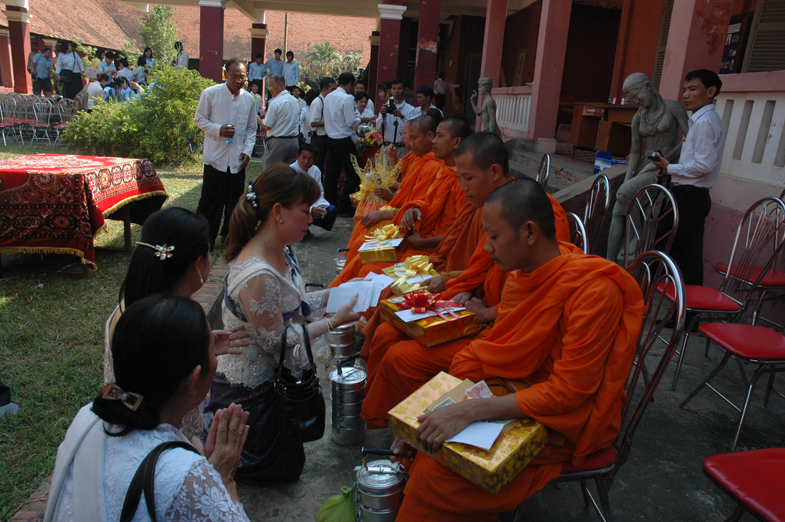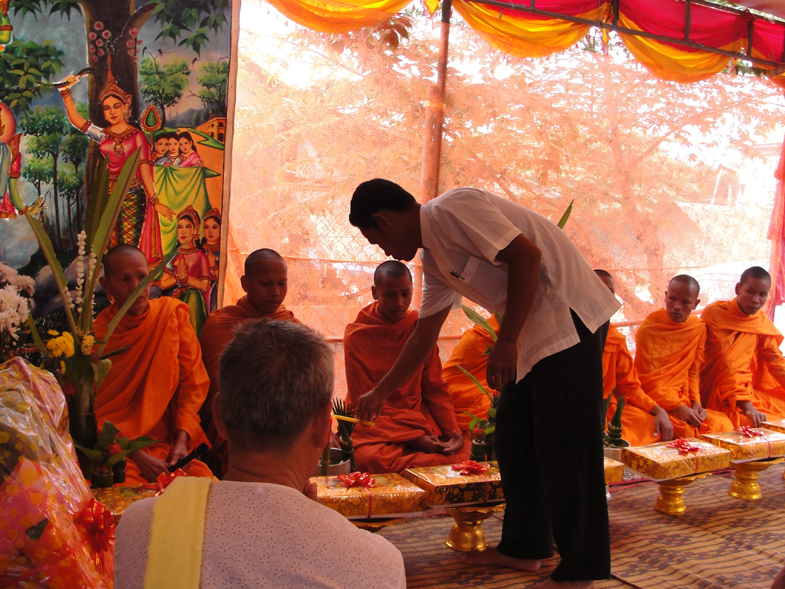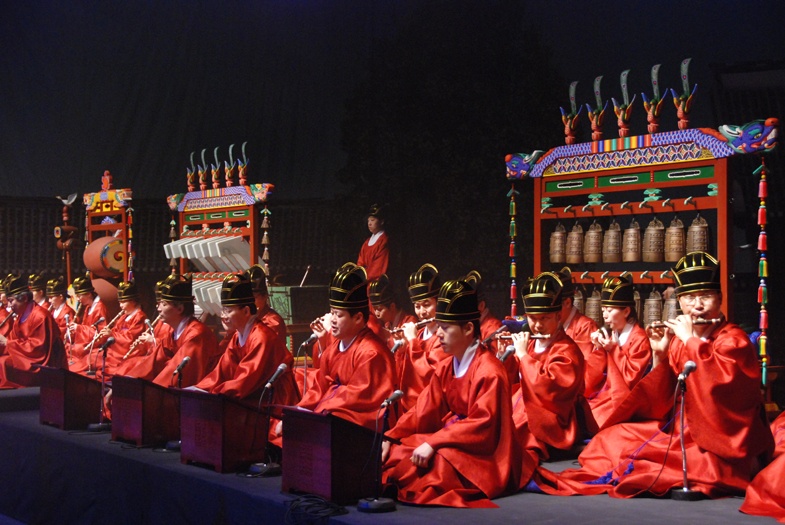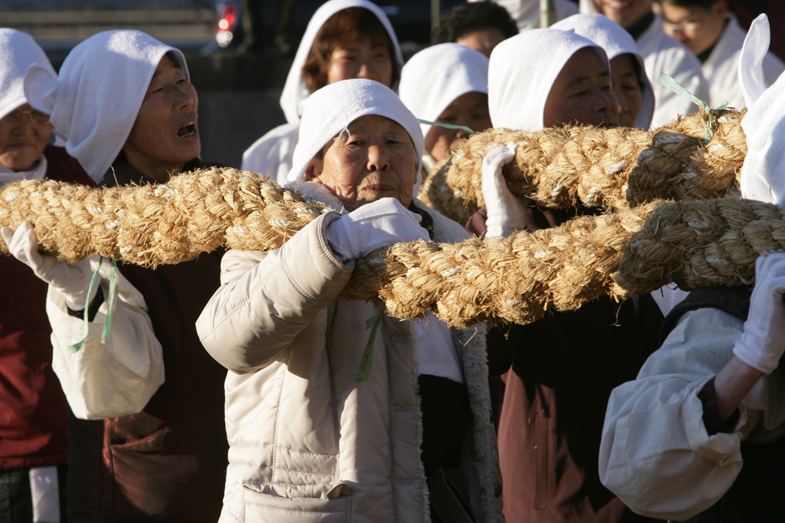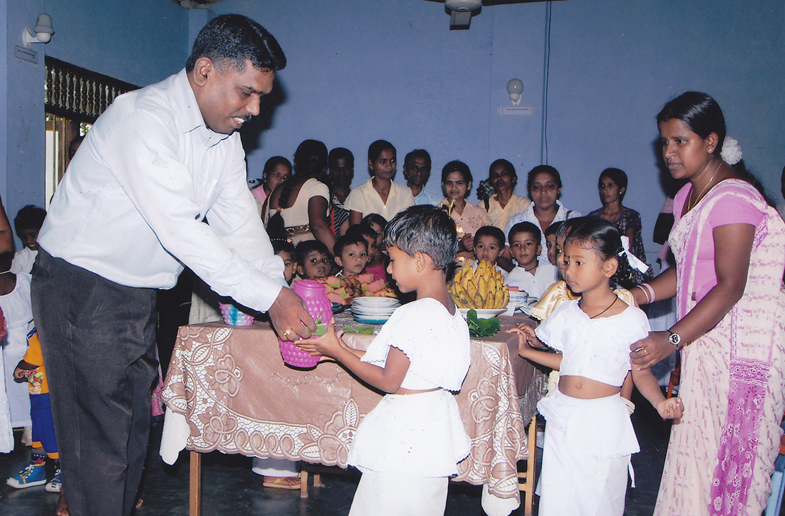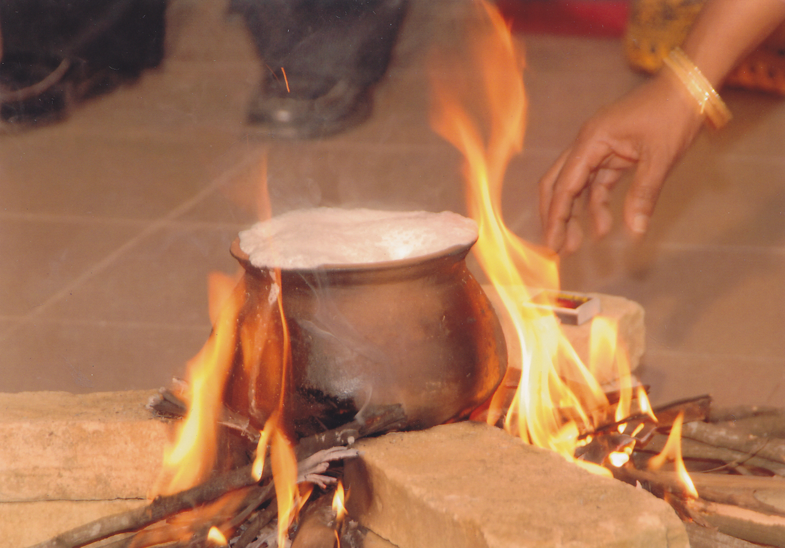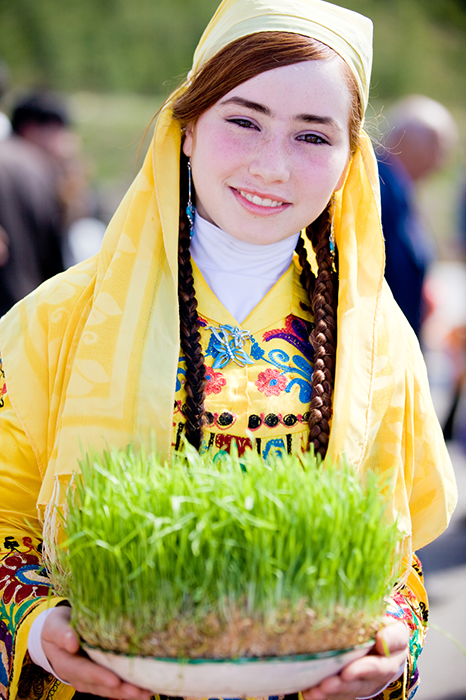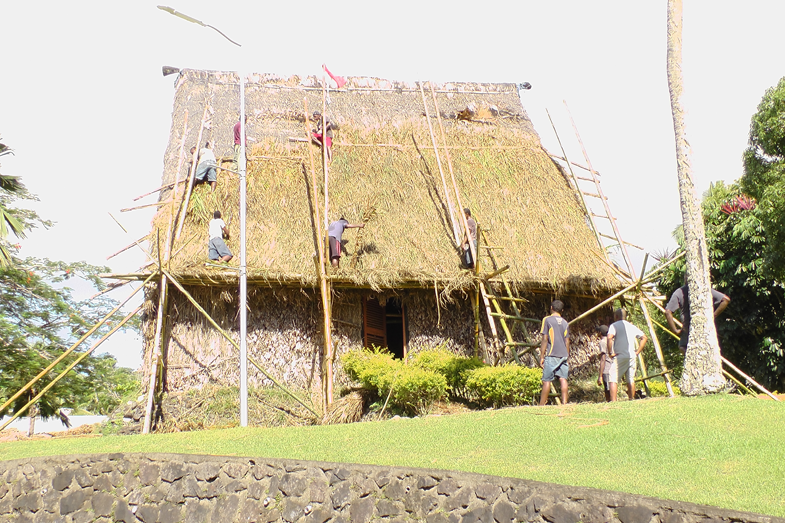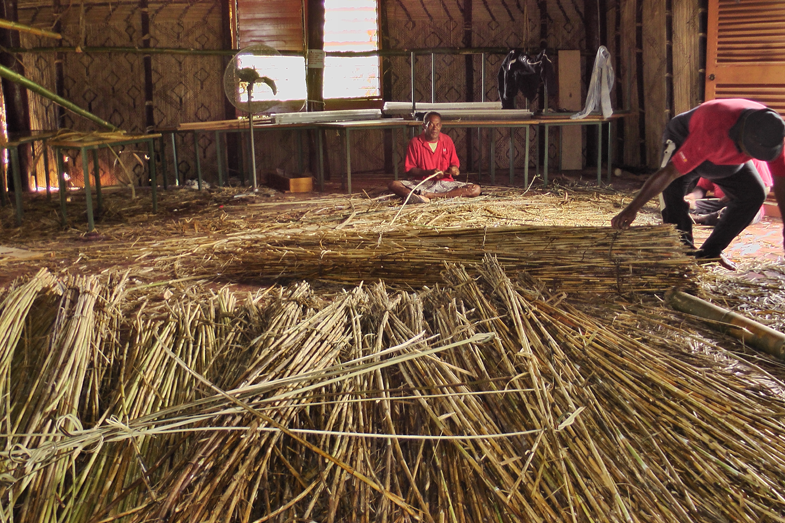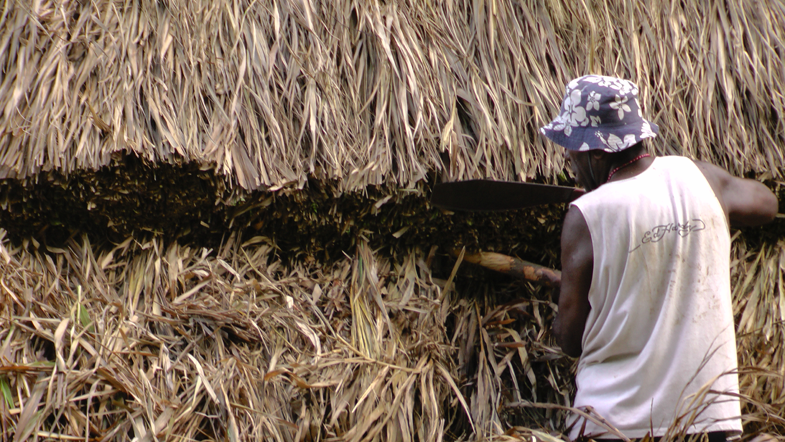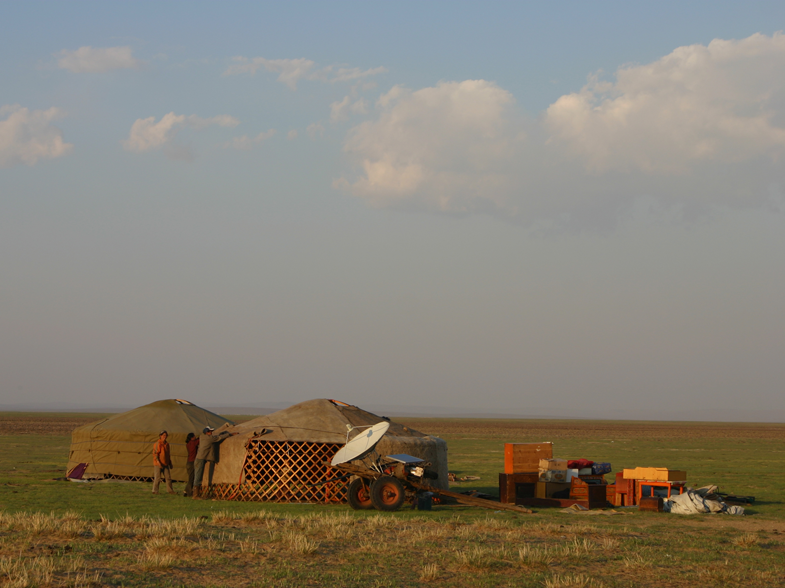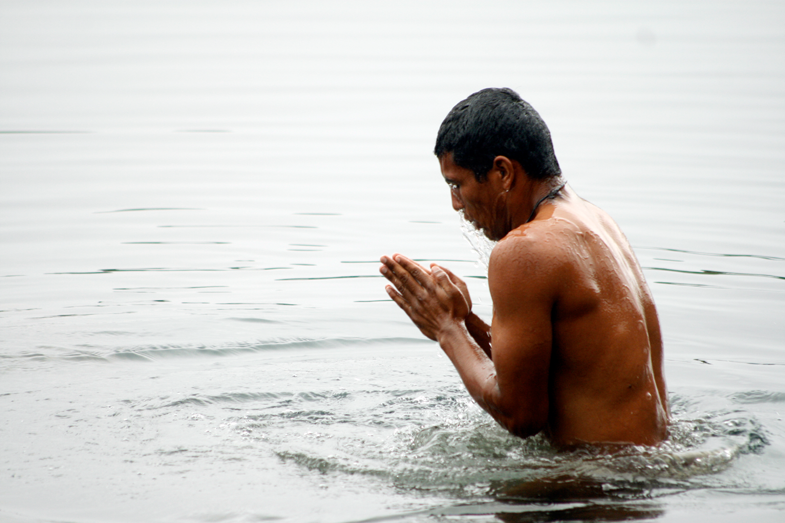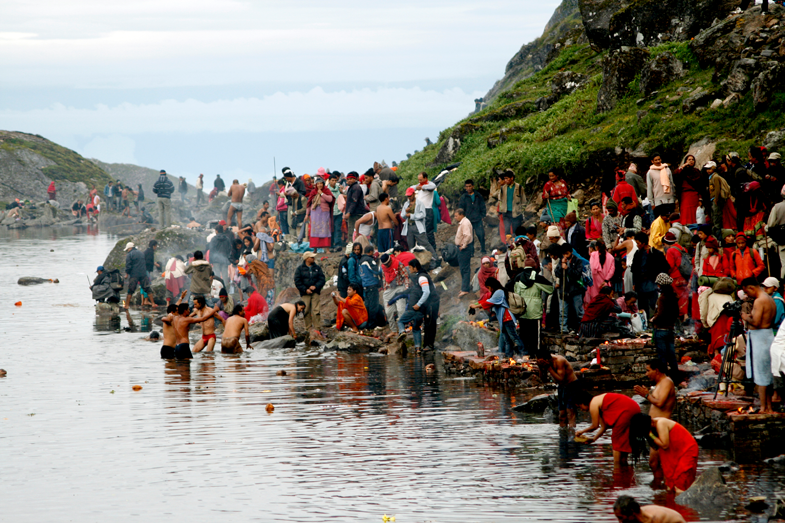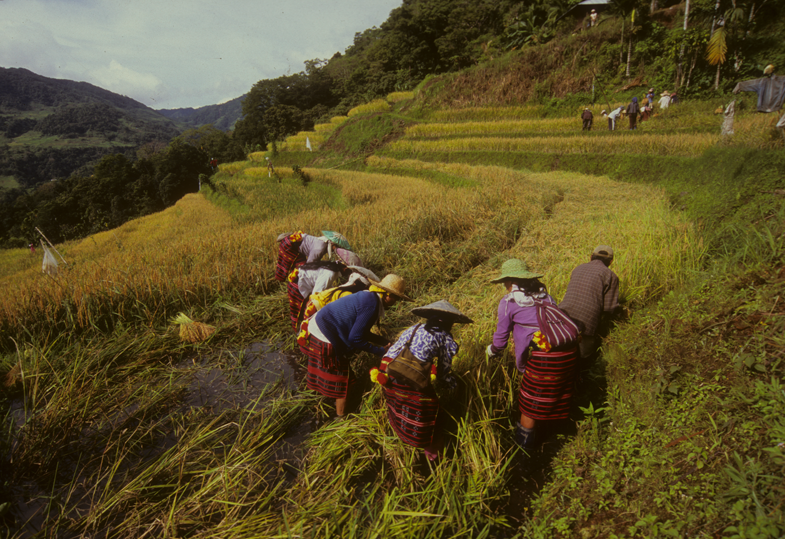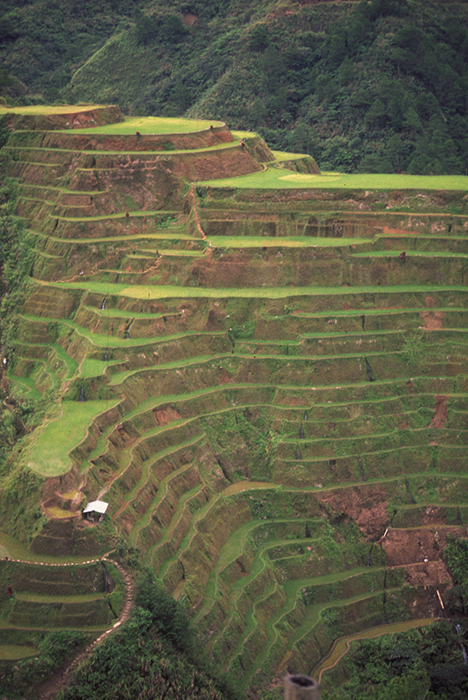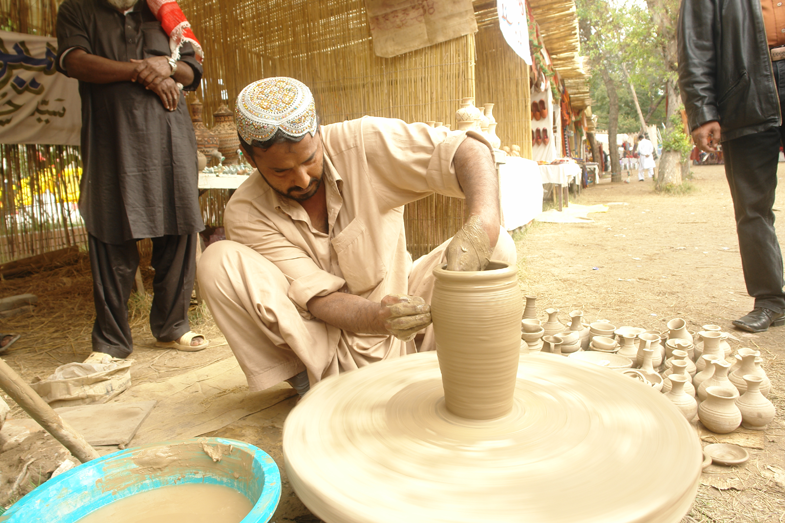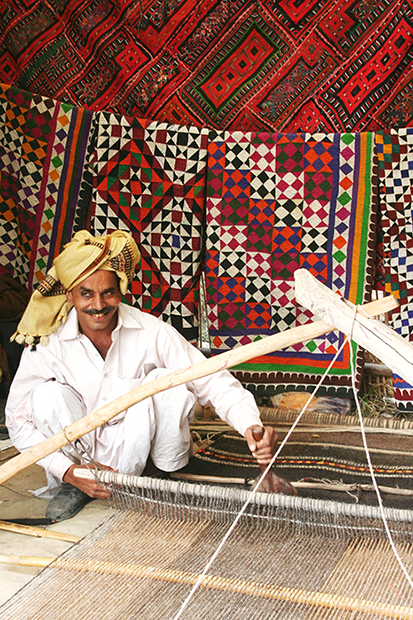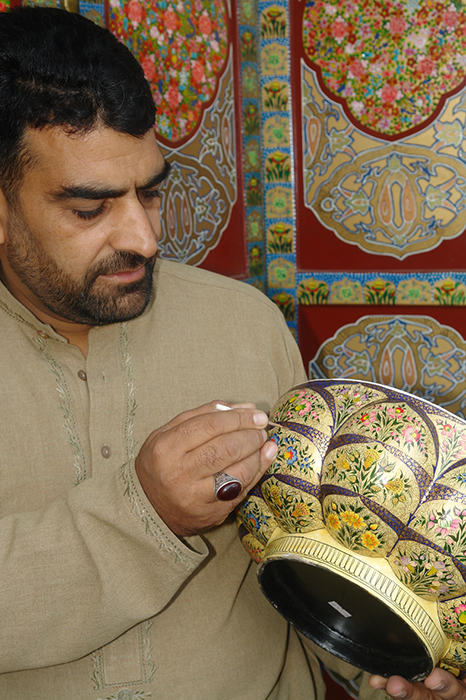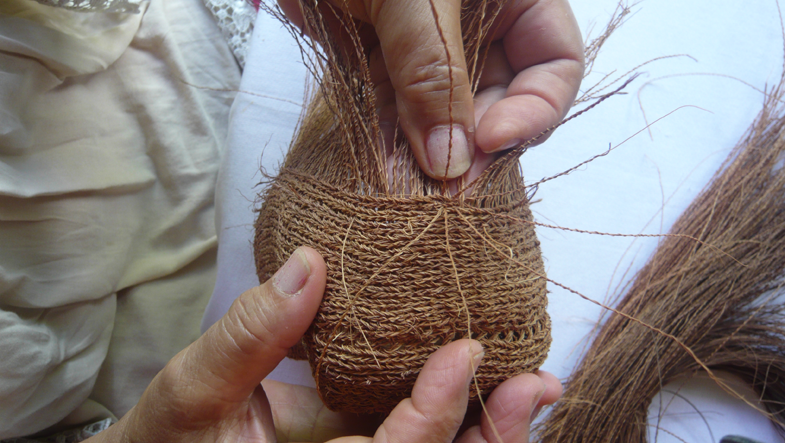The performing arts range from vocal and instrumental music, dance and theatre to pantomime, sung verse and beyond. They include numerous cultural expressions that reflect human creativity and that are also found, to some extent, in many other intangible cultural heritage domains.
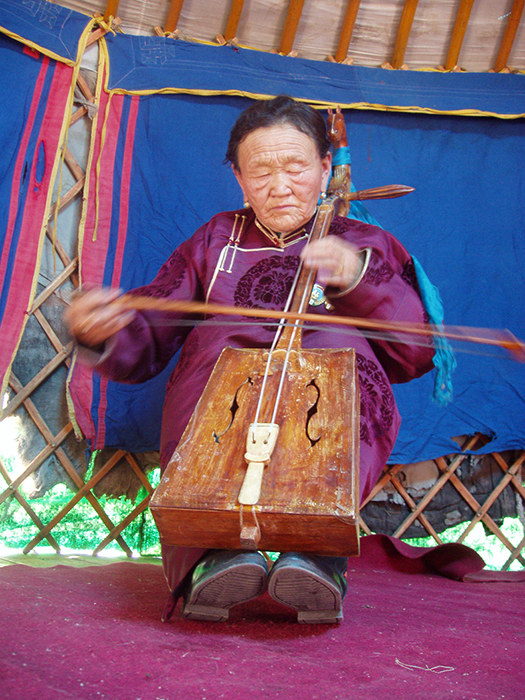
-
Mongolia
performing arts
Traditional Music of the Morin khuur
- The Mongols have traditionally shown great respect for the horse, honoring it in their national values and symbols (flags and emblems) as well as in folk songs. The morin khuur, so named for the ornamental horse-head carving at the top of its neck, is a unique two-stringed musical instrument developed by nomadic Mongols. The strings of both the bow and fiddle are made from the hair of a horse’s tail.
There is a legend among the Mongols which tells of the origin of the morin khuur: Once upon a time, a man was travelling on horseback in a faraway land. During the course of this long journey his beloved horse died. The man was full of sorrow and mourned a long time for his horse. Suddenly, he heard what sounded like music made by the wind through the horse’s main and tail, and decided to create a musical instrument in memory of his dear steed.
The morin khuur embraces an aggregation of Mongolian traditional customs and culture. Most significantly, there is a tradition of playing the morin khuur at all ritual and ceremonial events.
UNESCO inscribed the ‘Mongolian Traditional Music of the Morin Khuur’ as a Masterpiece of the Oral and Intangible Heritage of Humanity in 2003.

-
Mongolia
performing arts
Traditional Music of the Morin khuur
- The Mongols have traditionally shown great respect for the horse, honoring it in their national values and symbols (flags and emblems) as well as in folk songs. The morin khuur, so named for the ornamental horse-head carving at the top of its neck, is a unique two-stringed musical instrument developed by nomadic Mongols. The strings of both the bow and fiddle are made from the hair of a horse’s tail.
There is a legend among the Mongols which tells of the origin of the morin khuur: Once upon a time, a man was travelling on horseback in a faraway land. During the course of this long journey his beloved horse died. The man was full of sorrow and mourned a long time for his horse. Suddenly, he heard what sounded like music made by the wind through the horse’s main and tail, and decided to create a musical instrument in memory of his dear steed.
The morin khuur embraces an aggregation of Mongolian traditional customs and culture. Most significantly, there is a tradition of playing the morin khuur at all ritual and ceremonial events.
UNESCO inscribed the ‘Mongolian Traditional Music of the Morin Khuur’ as a Masterpiece of the Oral and Intangible Heritage of Humanity in 2003.
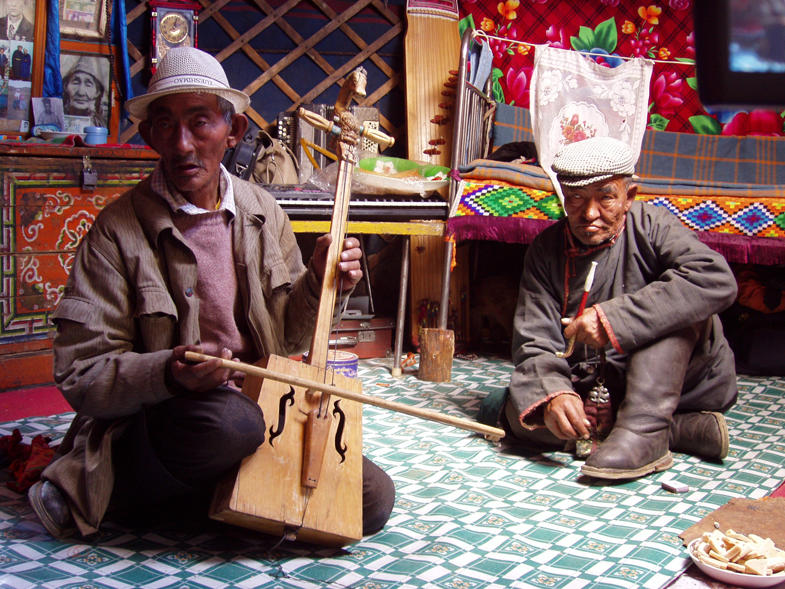
-
Mongolia
performing arts
Traditional Music of the Morin khuur
- The Mongols have traditionally shown great respect for the horse, honoring it in their national values and symbols (flags and emblems) as well as in folk songs. The morin khuur, so named for the ornamental horse-head carving at the top of its neck, is a unique two-stringed musical instrument developed by nomadic Mongols. The strings of both the bow and fiddle are made from the hair of a horse’s tail.
There is a legend among the Mongols which tells of the origin of the morin khuur: Once upon a time, a man was travelling on horseback in a faraway land. During the course of this long journey his beloved horse died. The man was full of sorrow and mourned a long time for his horse. Suddenly, he heard what sounded like music made by the wind through the horse’s main and tail, and decided to create a musical instrument in memory of his dear steed.
The morin khuur embraces an aggregation of Mongolian traditional customs and culture. Most significantly, there is a tradition of playing the morin khuur at all ritual and ceremonial events.
UNESCO inscribed the ‘Mongolian Traditional Music of the Morin Khuur’ as a Masterpiece of the Oral and Intangible Heritage of Humanity in 2003.

-
Mongolia
performing arts
Traditional Music of the Morin khuur
- The Mongols have traditionally shown great respect for the horse, honoring it in their national values and symbols (flags and emblems) as well as in folk songs. The morin khuur, so named for the ornamental horse-head carving at the top of its neck, is a unique two-stringed musical instrument developed by nomadic Mongols. The strings of both the bow and fiddle are made from the hair of a horse’s tail.
There is a legend among the Mongols which tells of the origin of the morin khuur: Once upon a time, a man was travelling on horseback in a faraway land. During the course of this long journey his beloved horse died. The man was full of sorrow and mourned a long time for his horse. Suddenly, he heard what sounded like music made by the wind through the horse’s main and tail, and decided to create a musical instrument in memory of his dear steed.
The morin khuur embraces an aggregation of Mongolian traditional customs and culture. Most significantly, there is a tradition of playing the morin khuur at all ritual and ceremonial events.
UNESCO inscribed the ‘Mongolian Traditional Music of the Morin Khuur’ as a Masterpiece of the Oral and Intangible Heritage of Humanity in 2003.
-
Bhutan
performing arts
Mask Dance
- Tshechu (literally means 10th day) is a religious event performed annually throughout Bhutan. It is an elaborate celebration where different kinds of mask dances are performed in commemorating its evolution ever since the 8th century by the great teacher Guru Rinpoche by transforming into wrathful manifestations who subdued malicious demons and evil forms to convert into follower and protector of Buddhist doctrines. Today, everyone in Bhutan believes that they should witness the mask dances to seek blessings and cleanse of accumulated sins with a spiritual mind.
The above picture depicts a Tum 'Ngam (gtum rngam) Cham performed at Jakar annual festival in Bumthang, Bhutan. It is a wrathful form of dance of Guru Rinpoche and is only performed by monks. However, it is widely performed in dzongs all across the country. It was introduced by Tertön Pema 'Lingpa in 15th Century. It requires thirteen numbers of dancers to perform.
-
Bhutan
performing arts
Mask Dance
- Tshechu (literally means 10th day) is a religious event performed annually throughout Bhutan. It is an elaborate celebration where different kinds of mask dances are performed in commemorating its evolution ever since the 8th century by the great teacher Guru Rinpoche by transforming into wrathful manifestations who subdued malicious demons and evil forms to convert into follower and protector of Buddhist doctrines. Today, everyone in Bhutan believes that they should witness the mask dances to seek blessings and cleanse of accumulated sins with a spiritual mind.
The above picture depicts a Tum 'Ngam (gtum rngam) Cham performed at Jakar annual festival in Bumthang, Bhutan. It is a wrathful form of dance of Guru Rinpoche and is only performed by monks. However, it is widely performed in dzongs all across the country. It was introduced by Tertön Pema 'Lingpa in 15th Century. It requires thirteen numbers of dancers to perform.
-
China
performing arts
Circle Dances of the Miao Ethnic Group
- The Miao people are a linguistically and culturally related ethnic group who settled in the Chinese provinces of Guizhou, Yunnan, Hunan and Guangxi. While the Miao are disbursed over a large area and are subdivided into a number of different branches, they share a common heritage element called the circle dance, a general category for carious dances that have their own particular content and purpose. Often accompanied by a lusheng (a bamboo musical instrument). the circle dance is the most important dance and the most popular among all Miao branches.
-
China
performing arts
Circle Dances of the Miao Ethnic Group
- The Miao people are a linguistically and culturally related ethnic group who settled in the Chinese provinces of Guizhou, Yunnan, Hunan and Guangxi. While the Miao are disbursed over a large area and are subdivided into a number of different branches, they share a common heritage element called the circle dance, a general category for carious dances that have their own particular content and purpose. Often accompanied by a lusheng (a bamboo musical instrument). the circle dance is the most important dance and the most popular among all Miao branches.
-
China
performing arts
Circle Dances of the Miao Ethnic Group
- The Miao people are a linguistically and culturally related ethnic group who settled in the Chinese provinces of Guizhou, Yunnan, Hunan and Guangxi. While the Miao are disbursed over a large area and are subdivided into a number of different branches, they share a common heritage element called the circle dance, a general category for carious dances that have their own particular content and purpose. Often accompanied by a lusheng (a bamboo musical instrument). the circle dance is the most important dance and the most popular among all Miao branches.
-
Thailand
performing arts
Shadow Play, Nang Yai
- The Nang is a shadow play, which uses figures perforated and cut from animal hide or leather (hence the word nang). The figures are manipulated from behind the screen; while the light(coming from a torch or a bonfire)beyond the backstage area throws the shadow of the figures onto a screen. The manipulation of the Nang is accompanied by narration, dialogue, and music.
-
Thailand
performing arts
Shadow Play, Nang Yai
- The Nang is a shadow play, which uses figures perforated and cut from animal hide or leather (hence the word nang). The figures are manipulated from behind the screen; while the light(coming from a torch or a bonfire)beyond the backstage area throws the shadow of the figures onto a screen. The manipulation of the Nang is accompanied by narration, dialogue, and music.
-
Thailand
performing arts
Shadow Play, Nang Yai
- The Nang is a shadow play, which uses figures perforated and cut from animal hide or leather (hence the word nang). The figures are manipulated from behind the screen; while the light(coming from a torch or a bonfire)beyond the backstage area throws the shadow of the figures onto a screen. The manipulation of the Nang is accompanied by narration, dialogue, and music.
-
Thailand
performing arts
Nora for entertainment
- Nora is a form of traditional, folk performing arts that is popular in the southern region of Thailand. The main elements and characteristics of Nora are the costume and the music. Nora costume comprises a soet for the principal performer–the “nora yai”. The costume is made of beads in various colours arranged in patterns and motifs, to be worn as a shirt. These are the costume and decorations for the principal character, who is called the nora yai or nora yuen, while the khrueang nang or the costume for the female characters does not have armlets, pendant, or wings.
-
Thailand
performing arts
Nora for entertainment
- Nora is a form of traditional, folk performing arts that is popular in the southern region of Thailand. The main elements and characteristics of Nora are the costume and the music. Nora costume comprises a soet for the principal performer–the “nora yai”. The costume is made of beads in various colours arranged in patterns and motifs, to be worn as a shirt. These are the costume and decorations for the principal character, who is called the nora yai or nora yuen, while the khrueang nang or the costume for the female characters does not have armlets, pendant, or wings.
-
Thailand
performing arts
Nora for entertainment
- Nora is a form of traditional, folk performing arts that is popular in the southern region of Thailand. The main elements and characteristics of Nora are the costume and the music. Nora costume comprises a soet for the principal performer–the “nora yai”. The costume is made of beads in various colours arranged in patterns and motifs, to be worn as a shirt. These are the costume and decorations for the principal character, who is called the nora yai or nora yuen, while the khrueang nang or the costume for the female characters does not have armlets, pendant, or wings.
-
Philippines
performing arts
Yakan Sonic Textures: A Heritage of
Musical Instruments
- The kwintangan, an instrument of five to seven bossed gongs laid in a row, are used for courtship and celebrations. The other major Yakan instruments are the kwintangan kayu, gabbang and agung. The kwintangan kayu consists of five wooden logs hung horizontally under a tree near a rice field. this instrument is used to serenade the palay (rice) plants from the seedling stage until the time of harvest. The Yakans believe that the resonated sounds of the instrument caress the palay plants in their sleep, encouraging them to yield more fruit.
-
Philippines
performing arts
Yakan Sonic Textures: A Heritage of
Musical Instruments
- The kwintangan, an instrument of five to seven bossed gongs laid in a row, are used for courtship and celebrations. The other major Yakan instruments are the kwintangan kayu, gabbang and agung. The kwintangan kayu consists of five wooden logs hung horizontally under a tree near a rice field. this instrument is used to serenade the palay (rice) plants from the seedling stage until the time of harvest. The Yakans believe that the resonated sounds of the instrument caress the palay plants in their sleep, encouraging them to yield more fruit.
-
Philippines
performing arts
Yakan Sonic Textures: A Heritage of
Musical Instruments
- The kwintangan, an instrument of five to seven bossed gongs laid in a row, are used for courtship and celebrations. The other major Yakan instruments are the kwintangan kayu, gabbang and agung. The kwintangan kayu consists of five wooden logs hung horizontally under a tree near a rice field. this instrument is used to serenade the palay (rice) plants from the seedling stage until the time of harvest. The Yakans believe that the resonated sounds of the instrument caress the palay plants in their sleep, encouraging them to yield more fruit.
The oral traditions and expressions domain encompasses an enormous variety of spoken forms including proverbs, riddles, tales, nursery rhymes, legends, myths, epic songs and poems, charms, prayers, chants, songs, dramatic performances and more. Oral traditions and expressions are used to pass on knowledge, cultural and social values and collective memory. They play a crucial part in keeping cultures alive.institutions to the importance of safeguarding Colombia’s intangible heritage.
-
Indonesia
oral traditions and expressions
Saman dance
- The Saman dance is cultural heritage of the Gayo people traceable to the 13th Century, developed later by Syeh Saman incorporating religious messages. Saman is performed by boys and young men, always in odd numbers, sitting on their heels or kneeling in tight rows. Saman is performed to celebrate national and religious holidays, and is a game among village children, who learn it informally. The frequency of Saman performances and transmission are decreasing, despite community and government efforts.
-
Indonesia
oral traditions and expressions
Saman dance
- The Saman dance is cultural heritage of the Gayo people traceable to the 13th Century, developed later by Syeh Saman incorporating religious messages. Saman is performed by boys and young men, always in odd numbers, sitting on their heels or kneeling in tight rows. Saman is performed to celebrate national and religious holidays, and is a game among village children, who learn it informally. The frequency of Saman performances and transmission are decreasing, despite community and government efforts.
-
Indonesia
oral traditions and expressions
Saman dance
- The Saman dance is cultural heritage of the Gayo people traceable to the 13th Century, developed later by Syeh Saman incorporating religious messages. Saman is performed by boys and young men, always in odd numbers, sitting on their heels or kneeling in tight rows. Saman is performed to celebrate national and religious holidays, and is a game among village children, who learn it informally. The frequency of Saman performances and transmission are decreasing, despite community and government efforts.
-
Nepal
oral traditions and expressions
Ramayana: the great Hindu epic
- Lord Rama(the seventh incarnation of Lord Vishnu, ‘The Preserver’) is referred to as Maryada Purushottam(the most superior man who embodies both divinity and humanity). Known as Rama Navami, it is a great Hindu festival which falls on the ninth day of the bright fortnight of Chaitra(March to April) and has been performed since time immemorial. The festival of Rama Navami is regarded as one of the five Mahavratas(great festivals). It is a festival to celebrate the performance of righteous duties, as well as being a ritual for marking attributes of victory of virtue over vice. It is also a day to mark his divine achievements which are an eternal source of ideal attributes for all humanity.
-
Nepal
oral traditions and expressions
Ramayana: the great Hindu epic
- Lord Rama(the seventh incarnation of Lord Vishnu, ‘The Preserver’) is referred to as Maryada Purushottam(the most superior man who embodies both divinity and humanity). Known as Rama Navami, it is a great Hindu festival which falls on the ninth day of the bright fortnight of Chaitra(March to April) and has been performed since time immemorial. The festival of Rama Navami is regarded as one of the five Mahavratas(great festivals). It is a festival to celebrate the performance of righteous duties, as well as being a ritual for marking attributes of victory of virtue over vice. It is also a day to mark his divine achievements which are an eternal source of ideal attributes for all humanity.
-
Nepal
oral traditions and expressions
Ramayana: the great Hindu epic
- Lord Rama(the seventh incarnation of Lord Vishnu, ‘The Preserver’) is referred to as Maryada Purushottam(the most superior man who embodies both divinity and humanity). Known as Rama Navami, it is a great Hindu festival which falls on the ninth day of the bright fortnight of Chaitra(March to April) and has been performed since time immemorial. The festival of Rama Navami is regarded as one of the five Mahavratas(great festivals). It is a festival to celebrate the performance of righteous duties, as well as being a ritual for marking attributes of victory of virtue over vice. It is also a day to mark his divine achievements which are an eternal source of ideal attributes for all humanity.
-
Vanuatu
oral traditions and expressions
Sand Drawings
- Sand drawing is traditionally practised throughout the central and northern area of the Vanuatu archipelago. Even though these historical circumstances have changed during the processes of colonization and post-colonial national ‘development’, sand drawing continues to function as a form of both cultural exchange and cultural distinction. Different communities within the central islands still practice particular styles of sand drawing in association with the stories and songs that are locally specific.
-
Vanuatu
oral traditions and expressions
Sand Drawings
- Sand drawing is traditionally practised throughout the central and northern area of the Vanuatu archipelago. Even though these historical circumstances have changed during the processes of colonization and post-colonial national ‘development’, sand drawing continues to function as a form of both cultural exchange and cultural distinction. Different communities within the central islands still practice particular styles of sand drawing in association with the stories and songs that are locally specific.
Social practices, rituals and festive events are habitual activities that structure the lives of communities and groups and that are shared by and relevant to many of their members. They are significant because they reaffirm the identity of those who practise them as a group or a society and, whether performed in public or private, are closely linked to important events. Social, ritual and festive practices may help to mark the passing of the seasons, events in the agricultural calendar or the stages of a person’s life. They are closely linked to a community’s worldview and perception of its own history and memory. They vary from small gatherings to large-scale social celebrations and commemorations. Each of these sub-domains is vast but there is also a great deal of overlap between them.
-
Cambodia
Social Practices, Rituals and Festive Events
Celebrating Khmer New Year Festival
- In Cambodian society, the Khmer New Year Festival combines different forms of religious rituals and practices. The rituals are usually performed at three different locations: at a Buddhist pagoda, at an ancestral stupa, and at home. The New Year celebration is a symbol reuniting the Cambodian people, ancestral spirits, and gods, and, most importantly, it is an expression of happiness in society. The New Year festival itself embraces many forms of intangible cultural heritage that are rarely seen on other occasions.
-
Cambodia
Social Practices, Rituals and Festive Events
Celebrating Khmer New Year Festival
- In Cambodian society, the Khmer New Year Festival combines different forms of religious rituals and practices. The rituals are usually performed at three different locations: at a Buddhist pagoda, at an ancestral stupa, and at home. The New Year celebration is a symbol reuniting the Cambodian people, ancestral spirits, and gods, and, most importantly, it is an expression of happiness in society. The New Year festival itself embraces many forms of intangible cultural heritage that are rarely seen on other occasions.
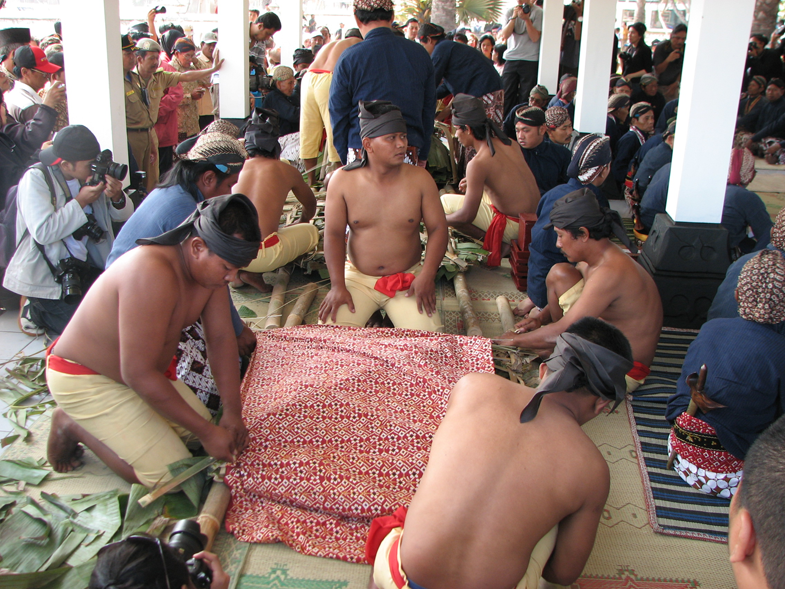
-
Indonesia
Social Practices, Rituals and Festive Events
Kanjeng Ratu Kidul
– Goddess of the Southern Ocean
- Along the southern coast of Java, in places like Pareng Kusuma, Pelabuhan Ratu and Cilacap, some people still believe in Ratu Kidul and make offerings on special occasions. At least three times a year, large crowds converge at Pareng Kusuma to witness the larung ceremony in which three palanquins containing offerings including batik cloth worn by the Sultan are taken to the ocean in ceremonial procession and submerged. Annually on the eve of the Javanese New Year (called Sura) thousands gather on Pareng Kusuma beach, and some make flower offerings. On the anniversary of the King’s ascension to the throne, the sacred Bedoyo Ketawang Dance is peformed annually before the kings in Java and symbolises the meeting of the king with anjeng Ratu Kidul, who is believed to appear and mystically guide the dancers. The goddess is depicted as an exceptionally beautiful woman dressed in greenish cloth, residing on the ocean floor with her many servants. Out of respect for the goddess, wearing green is still considered taboo for visitors to the south coast of Java. Ratu Kidul is believed to be a spiritual being who provides guidance to leaders, while her servants may also inflict punishments in the form of natural disasters if leaders neglect to perform noble actions for the benefit and welfare of the people.
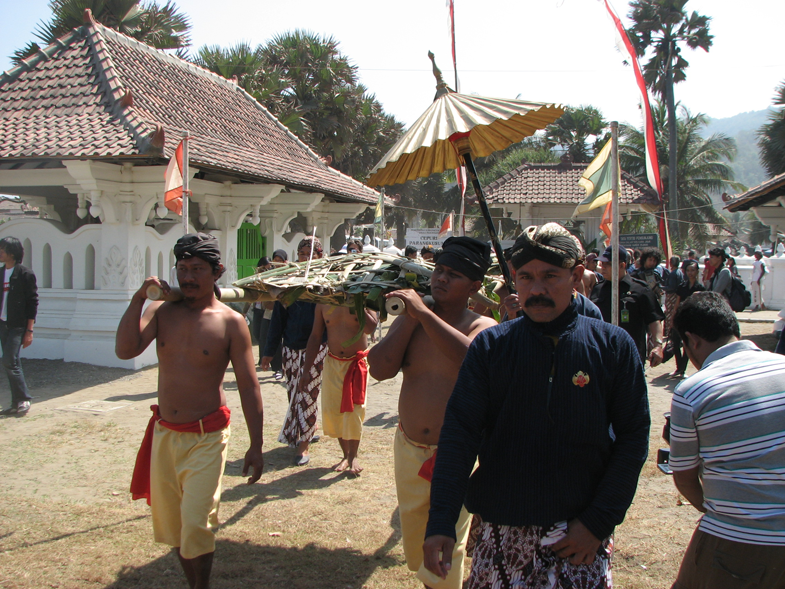
-
Indonesia
Social Practices, Rituals and Festive Events
Kanjeng Ratu Kidul
– Goddess of the Southern Ocean
- Along the southern coast of Java, in places like Pareng Kusuma, Pelabuhan Ratu and Cilacap, some people still believe in Ratu Kidul and make offerings on special occasions. At least three times a year, large crowds converge at Pareng Kusuma to witness the larung ceremony in which three palanquins containing offerings including batik cloth worn by the Sultan are taken to the ocean in ceremonial procession and submerged. Annually on the eve of the Javanese New Year (called Sura) thousands gather on Pareng Kusuma beach, and some make flower offerings. On the anniversary of the King’s ascension to the throne, the sacred Bedoyo Ketawang Dance is peformed annually before the kings in Java and symbolises the meeting of the king with anjeng Ratu Kidul, who is believed to appear and mystically guide the dancers. The goddess is depicted as an exceptionally beautiful woman dressed in greenish cloth, residing on the ocean floor with her many servants. Out of respect for the goddess, wearing green is still considered taboo for visitors to the south coast of Java. Ratu Kidul is believed to be a spiritual being who provides guidance to leaders, while her servants may also inflict punishments in the form of natural disasters if leaders neglect to perform noble actions for the benefit and welfare of the people.
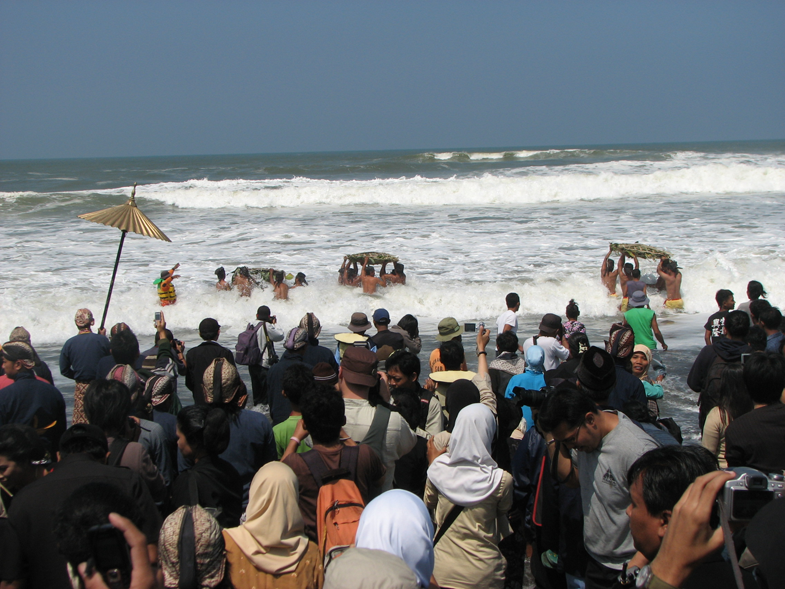
-
Indonesia
Social Practices, Rituals and Festive Events
Kanjeng Ratu Kidul
– Goddess of the Southern Ocean
- Along the southern coast of Java, in places like Pareng Kusuma, Pelabuhan Ratu and Cilacap, some people still believe in Ratu Kidul and make offerings on special occasions. At least three times a year, large crowds converge at Pareng Kusuma to witness the larung ceremony in which three palanquins containing offerings including batik cloth worn by the Sultan are taken to the ocean in ceremonial procession and submerged. Annually on the eve of the Javanese New Year (called Sura) thousands gather on Pareng Kusuma beach, and some make flower offerings. On the anniversary of the King’s ascension to the throne, the sacred Bedoyo Ketawang Dance is peformed annually before the kings in Java and symbolises the meeting of the king with anjeng Ratu Kidul, who is believed to appear and mystically guide the dancers. The goddess is depicted as an exceptionally beautiful woman dressed in greenish cloth, residing on the ocean floor with her many servants. Out of respect for the goddess, wearing green is still considered taboo for visitors to the south coast of Java. Ratu Kidul is believed to be a spiritual being who provides guidance to leaders, while her servants may also inflict punishments in the form of natural disasters if leaders neglect to perform noble actions for the benefit and welfare of the people.
-
Korea
Social Practices, Rituals and Festive Events
Munmyo Jerye, Grand Ceremony
in Honor of Confucius
- Munmyo is a Confucian shrine in which various spiritual-tablets of past Confucian scholars rest. In this shrine, a total of thirty nine spiritual-tablets are enshrined that belong to
Confucius, four disciples, sixteen Chinese Confucian scholars, and eighteen Korean Confucian scholars. Every February and August, according to the lunar calendar, commemorative rites are prepared and Currently, Seokjeonje is listed as No. 85 on the Important Intangible Cultural Heritage List of Korea, designated in 1986.
-
Korea
Social Practices, Rituals and Festive Events
Daeboreum Folk and Cultural Diversity
- Rituals are shaped differently in each community, and the same ritual may differ from region to region. During Daeboreum, farmers and other community members play musical instruments, and community rituals are performed. In rice farming areas, straw collected from each family house is twisted to make a rope for Daeboreum juldarigi (tug-of-war), an event in which the counterparties may be decided by gender or by residence. After juldarigi events are completed, the rope is burnt or cut and taken away, or sometimes it is tied around a standing stone or dangsan (a village shrine). The way of handling the rope is as varied as the regional customs involved with juldarigi.
-
Srilanka
Social Practices, Rituals and Festive Events
New Year Festival as Living Heritage
- In mid-April every year, Sri Lankans celebrate the Sinhala and Hindu New Year with distinctive rituals that fuse Hindu and Buddhist elements. With the introduction of Buddhism in the third century BCE, traditional Hindu New Year rituals were reinterpreted. While historians and sociologists believe these rituals were closely related to sun worship because they coincided with ancient myths about the sun moving from one celestial house to another—the major rituals today embody a sense of cultural heredity and tradition.
-
Srilanka
Social Practices, Rituals and Festive Events
New Year Festival as Living Heritage
- In mid-April every year, Sri Lankans celebrate the Sinhala and Hindu New Year with distinctive rituals that fuse Hindu and Buddhist elements. With the introduction of Buddhism in the third century BCE, traditional Hindu New Year rituals were reinterpreted. While historians and sociologists believe these rituals were closely related to sun worship because they coincided with ancient myths about the sun moving from one celestial house to another—the major rituals today embody a sense of cultural heredity and tradition.
-
Srilanka
Social Practices, Rituals and Festive Events
New Year Festival as Living Heritage
- In mid-April every year, Sri Lankans celebrate the Sinhala and Hindu New Year with distinctive rituals that fuse Hindu and Buddhist elements. With the introduction of Buddhism in the third century BCE, traditional Hindu New Year rituals were reinterpreted. While historians and sociologists believe these rituals were closely related to sun worship because they coincided with ancient myths about the sun moving from one celestial house to another—the major rituals today embody a sense of cultural heredity and tradition.
-
Multinational
Social Practices, Rituals and Festive Events
Navruz, Sharing Together on New Year's Day
- Novruz, Nowrouz, Nooruz, Navruz, Nauroz, Nevruz is celebrated on 21st of March, which is considered as New Year holiday and the beginning of Spring. There are various ceremonies, rituals, and cultural events held within every family and community. Values of peace and solidarity, reconciliation and neighbourhood, cultural diversity and tolerance, healthy life-style and renewal of living environment are promoted and transmitted from generation to generation during this cultural event. Women play a major role in the cultural event, by managing the ceremonies and disseminating the traditional knowledge to the youth. It is a part of and strengthens the cultural identity of the states parties involved expressions.
Knowledge and Practices Concerning Nature and The Universe include knowledge, knowhow, skills, practices and representations developed by communities by interacting with the natural environment. These ways of thinking about the universe are expressed through language, oral traditions, feelings of attachment towards a place, memories, spirituality and worldview. They also strongly influence values and beliefs and underlie many social practices and cultural traditions. They, in turn, are shaped by the natural environment and the community’s wider world.
-
Fiji
Knowledge and Practices Concerning
Nature and The Universe
The Fijian Traditional Bure
- The bure is made of natural materials-reeds, hardwood posts, stones, bamboo, sinnet, and ferns. It is said that such was the ingenuity its construction that in hot and humid weather, the interior of a bure remained cool. But as Fiji entered into colonialism, the moorings of traditional knowledge and inheritance began to wane to such an extent that it is so rare to find these wonderful works of architecture around the country.
-
Fiji
Knowledge and Practices Concerning
Nature and The Universe
The Fijian Traditional Bure
- The bure is made of natural materials-reeds, hardwood posts, stones, bamboo, sinnet, and ferns. It is said that such was the ingenuity its construction that in hot and humid weather, the interior of a bure remained cool. But as Fiji entered into colonialism, the moorings of traditional knowledge and inheritance began to wane to such an extent that it is so rare to find these wonderful works of architecture around the country.
-
Fiji
Knowledge and Practices Concerning
Nature and The Universe
The Fijian Traditional Bure
- The bure is made of natural materials-reeds, hardwood posts, stones, bamboo, sinnet, and ferns. It is said that such was the ingenuity its construction that in hot and humid weather, the interior of a bure remained cool. But as Fiji entered into colonialism, the moorings of traditional knowledge and inheritance began to wane to such an extent that it is so rare to find these wonderful works of architecture around the country.
-
Mongolia
Knowledge and Practices Concerning
Nature and The Universe
Practice of Constructing the Mongolian Ger
- The ger, a traditional dwelling created by nomadic Mongolians, is specifically designed to fit their way of life. Its semisphere shape helps the ger endure storms and tempests. It has solutions for heat control and ventilation. It is flexible in terms of size and design, and it is portable and lightweight. Over the course of history, Mongolians have re-created and developed the ger and have accumulated extensive knowledge associated to its ritual, craftsmanship, and traditional customs.
-
Mongolia
Knowledge and Practices Concerning
Nature and The Universe
Practice of Constructing the Mongolian Ger
- The ger, a traditional dwelling created by nomadic Mongolians, is specifically designed to fit their way of life. Its semisphere shape helps the ger endure storms and tempests. It has solutions for heat control and ventilation. It is flexible in terms of size and design, and it is portable and lightweight. Over the course of history, Mongolians have re-created and developed the ger and have accumulated extensive knowledge associated to its ritual, craftsmanship, and traditional customs.
-
Mongolia
Knowledge and Practices Concerning
Nature and The Universe
Practice of Constructing the Mongolian Ger
- The ger, a traditional dwelling created by nomadic Mongolians, is specifically designed to fit their way of life. Its semisphere shape helps the ger endure storms and tempests. It has solutions for heat control and ventilation. It is flexible in terms of size and design, and it is portable and lightweight. Over the course of history, Mongolians have re-created and developed the ger and have accumulated extensive knowledge associated to its ritual, craftsmanship, and traditional customs.
-
Nepal
Knowledge and Practices Concerning
Nature and The Universe
Gosainkunda Pilgrimage
- Gosainkunda is a pond situated in the laps of Himalayas. A huge fair takes place around this pond during Ganga Dashara and Janai Purnima every year. Pilgrims bathe in the pond and offer prayers to Lord Mahadev as it is believed to be of extreme religious significance. A lot of myth surfaces regarding the origin of this pond. The story of Samudra Manthan among the Gods and the Devils is associated with this pond. The myth of Lord Shiva drinking poison extracted from Samudra Manthan, and later shoving his Trishul in the Himalayas to create a pool that he could immerse himself in to calm effect of poison has been believed to be the cause of the holy pond's origin. Tourists with both religious and sightseeing intentions visit this pond.
-
Nepal
Knowledge and Practices Concerning
Nature and The Universe
Gosainkunda Pilgrimage
- Gosainkunda is a pond situated in the laps of Himalayas. A huge fair takes place around this pond during Ganga Dashara and Janai Purnima every year. Pilgrims bathe in the pond and offer prayers to Lord Mahadev as it is believed to be of extreme religious significance. A lot of myth surfaces regarding the origin of this pond. The story of Samudra Manthan among the Gods and the Devils is associated with this pond. The myth of Lord Shiva drinking poison extracted from Samudra Manthan, and later shoving his Trishul in the Himalayas to create a pool that he could immerse himself in to calm effect of poison has been believed to be the cause of the holy pond's origin. Tourists with both religious and sightseeing intentions visit this pond.
-
Nepal
Knowledge and Practices Concerning
Nature and The Universe
Gosainkunda Pilgrimage
- Gosainkunda is a pond situated in the laps of Himalayas. A huge fair takes place around this pond during Ganga Dashara and Janai Purnima every year. Pilgrims bathe in the pond and offer prayers to Lord Mahadev as it is believed to be of extreme religious significance. A lot of myth surfaces regarding the origin of this pond. The story of Samudra Manthan among the Gods and the Devils is associated with this pond. The myth of Lord Shiva drinking poison extracted from Samudra Manthan, and later shoving his Trishul in the Himalayas to create a pool that he could immerse himself in to calm effect of poison has been believed to be the cause of the holy pond's origin. Tourists with both religious and sightseeing intentions visit this pond.
-
Philippines
Knowledge and Practices Concerning
Nature and The Universe
Mountain Terraces of the Ifugao
- The mountain terraces in the cordilleras of northern Luzon, Philippines were included in the UNESCO World Heritage Sites list in 1995. The Ifugao terraces are not actually carved out of the mountain side, rather, these are stone or earth walls which have been developed slowly by geological means; as the space between the wall and the mountain side fills up with different layers of rubble, grades of soil and water impervious clay beneath layers of organic soil to present water loss in the paddy fields thus created.
-
Philippines
Knowledge and Practices Concerning
Nature and The Universe
Mountain Terraces of the Ifugao
- The mountain terraces in the cordilleras of northern Luzon, Philippines were included in the UNESCO World Heritage Sites list in 1995. The Ifugao terraces are not actually carved out of the mountain side, rather, these are stone or earth walls which have been developed slowly by geological means; as the space between the wall and the mountain side fills up with different layers of rubble, grades of soil and water impervious clay beneath layers of organic soil to present water loss in the paddy fields thus created.
-
Philippines
Knowledge and Practices Concerning
Nature and The Universe
Mountain Terraces of the Ifugao
- The mountain terraces in the cordilleras of northern Luzon, Philippines were included in the UNESCO World Heritage Sites list in 1995. The Ifugao terraces are not actually carved out of the mountain side, rather, these are stone or earth walls which have been developed slowly by geological means; as the space between the wall and the mountain side fills up with different layers of rubble, grades of soil and water impervious clay beneath layers of organic soil to present water loss in the paddy fields thus created.
Traditional craftsmanshipis perhaps the most tangible manifestation of intangible cultural heritage. However, the 2003 Convention is mainly concerned with the skills and knowledge involved in craftsmanship rather than the craft products themselves. Rather than focusing on preserving craft objects, safeguarding attempts should instead concentrate on encouraging artisans to continue to produce craft and to pass their skills and knowledge onto theirs, particularly within their own communities.
-
Malaysia
Traditional Craftsmanship
Pandanus Leaf Weavings of
the Orang Asli
- A common plant found in or nearby Orang Asli villages are acrew pines or Pandanus fascicularis, a clumping plant with long, thorny leaves. The fibrous leaves are harvested, processed, and dyed before the leaf strips are woven by women into a variety of mats, baskets, and pouches. Orang Asli handicrafts are often utilitarian in nature, but with availability of cheap plastic replicates of mats and other products, the art of Pandanus weaving (anyam) is now on the wane. The synthetic products have slowly been replacing the crafts that were once woven from wild or cultivated Pandanus harvests. Overall, efforts to ensure the continuation of Orang Asli Pandanus weaving should focus on encouraging women not only to weave, but also to appreciate that their craft heritage was shaped by valuable communally shared knowledge that is still relevant today.
-
Malaysia
Traditional Craftsmanship
Pandanus Leaf Weavings of
the Orang Asli
- A common plant found in or nearby Orang Asli villages are acrew pines or Pandanus fascicularis, a clumping plant with long, thorny leaves. The fibrous leaves are harvested, processed, and dyed before the leaf strips are woven by women into a variety of mats, baskets, and pouches. Orang Asli handicrafts are often utilitarian in nature, but with availability of cheap plastic replicates of mats and other products, the art of Pandanus weaving (anyam) is now on the wane. The synthetic products have slowly been replacing the crafts that were once woven from wild or cultivated Pandanus harvests. Overall, efforts to ensure the continuation of Orang Asli Pandanus weaving should focus on encouraging women not only to weave, but also to appreciate that their craft heritage was shaped by valuable communally shared knowledge that is still relevant today.
-
Malaysia
Traditional Craftsmanship
Pandanus Leaf Weavings of
the Orang Asli
- A common plant found in or nearby Orang Asli villages are acrew pines or Pandanus fascicularis, a clumping plant with long, thorny leaves. The fibrous leaves are harvested, processed, and dyed before the leaf strips are woven by women into a variety of mats, baskets, and pouches. Orang Asli handicrafts are often utilitarian in nature, but with availability of cheap plastic replicates of mats and other products, the art of Pandanus weaving (anyam) is now on the wane. The synthetic products have slowly been replacing the crafts that were once woven from wild or cultivated Pandanus harvests. Overall, efforts to ensure the continuation of Orang Asli Pandanus weaving should focus on encouraging women not only to weave, but also to appreciate that their craft heritage was shaped by valuable communally shared knowledge that is still relevant today.
-
Pakistan
Traditional craftsmanship
Farasi weaving and Papier Mache
- Handicrafts is the major theme of the small industries and cottage industry of the state for its promotion and projection.
Then there are number of traditional crafts which are also facing the danger of total disappearance e.g. Hand Woven Sussi(stripped cloth used for ladies trousers), Taggar (hand woven floor rug from Tank, Dera Ismail Khan, Khyber Pakhtoon Kha), Wax Painting (Peshawar, KPK) and many others.
-
Pakistan
Traditional craftsmanship
Farasi weaving and Papier Mache
- Handicrafts is the major theme of the small industries and cottage industry of the state for its promotion and projection.
Then there are number of traditional crafts which are also facing the danger of total disappearance e.g. Hand Woven Sussi(stripped cloth used for ladies trousers), Taggar (hand woven floor rug from Tank, Dera Ismail Khan, Khyber Pakhtoon Kha), Wax Painting (Peshawar, KPK) and many others.
-
Pakistan
Traditional craftsmanship
Farasi weaving and Papier Mache
- Handicrafts is the major theme of the small industries and cottage industry of the state for its promotion and projection.
Then there are number of traditional crafts which are also facing the danger of total disappearance e.g. Hand Woven Sussi(stripped cloth used for ladies trousers), Taggar (hand woven floor rug from Tank, Dera Ismail Khan, Khyber Pakhtoon Kha), Wax Painting (Peshawar, KPK) and many others.
-
Tonga
Traditional craftsmanship
Traditional Weavings of Tonga
- Mosikaka weaving is special to Tongans, who identify themselves with the craft. It is a distinct art form that belongs to Tongans and no one else. Historically, mosikaka basket making was done for royalty alone. At the same time that mosikaka weaving is revered, it is also is a very rare, not only in terms of the resource material used but also in the process of doing the actual weaving. Mosikaka weaving is an identity of Tongan cultural heritage. It needs reviving and safeguarding, and it needs to be taught and practiced in schools and the community.
-
Tonga
Traditional craftsmanship
Traditional Weavings of Tonga
- Mosikaka weaving is special to Tongans, who identify themselves with the craft. It is a distinct art form that belongs to Tongans and no one else. Historically, mosikaka basket making was done for royalty alone. At the same time that mosikaka weaving is revered, it is also is a very rare, not only in terms of the resource material used but also in the process of doing the actual weaving. Mosikaka weaving is an identity of Tongan cultural heritage. It needs reviving and safeguarding, and it needs to be taught and practiced in schools and the community.
-
Tonga
Traditional craftsmanship
Traditional Weavings of Tonga
- Mosikaka weaving is special to Tongans, who identify themselves with the craft. It is a distinct art form that belongs to Tongans and no one else. Historically, mosikaka basket making was done for royalty alone. At the same time that mosikaka weaving is revered, it is also is a very rare, not only in terms of the resource material used but also in the process of doing the actual weaving. Mosikaka weaving is an identity of Tongan cultural heritage. It needs reviving and safeguarding, and it needs to be taught and practiced in schools and the community.



























